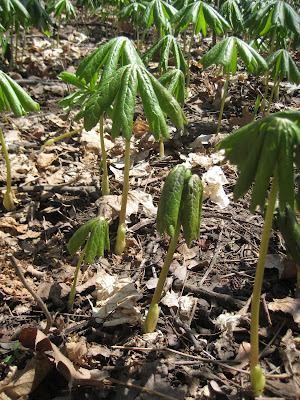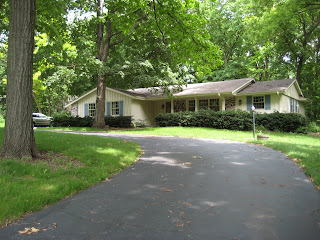Author: Kim W
Mother Nature’s Garden
April 26, 2010
If I consider my knowledge of shade plants to be lacking, my knowledge of wildflowers and natives is even worse. My last two gardens have been around new construction. New construction in both cases on land that had been farm fields. No trees means no shade. And years of row crop cultivation means no native plants (and in the case of the last garden, thanks to the developer, no topsoil, but that’s an entirely different story).
I found a couple of patches of another little darling. But have no clue to it’s identity.
And of course, the May Apples (Podophyllum peltatum ). Lots and lots of May Apples.
I’ve always been fond of May Apples. Even from afar they reminded me of little umbrellas for fairies. This is the first year I’ve been able to view them up close. They first emerge as a tight little mass, and then slowly unfurl.
The flags through the May Apples mark the boundaries of the pet “fence” which keeps my cat and dog in the yard. This of course, does not prevent other animals from entering the yard. We have an opossum which frequents under our deck. Last week as I left for a pre-dawn plane flight, the cat snuck out. My husband and son were awoken by a growling scream to discover a large red fox had cornered the cat (who has lost her out side in the dark priviledges). But the best was the deer last summer that seemed to love tormenting the dog by calming eating foliage just outside of invisible fence line. Excuse the picture clarity – all I had was my phone, and couldn’t get close because I didn’t want to scare the deer. As if that is possible, here in the wild, wild woods of suburbia!
Making the Bed(lines)
April 25, 2010
My serious garden project of the season is re-doing the beds along the front of the house. When we first bought the house two summers ago, this area was solid yews. To say that I am not a fan of yews, would be a gross understatement. I detest them.
This was the view in July of 2008.
Wordless Wednesday: Grand Rapids walk
April 22, 2010

Making progress
April 20, 2010
Still not time to plant, but there’s plenty to do in the meantime. Trying to work my way around the house cleaning up the existing beds. All of which appear to have been ignored for years.
This weekend I decided to focus on cleaning up the south side of the house. This is the sloped area with the retaining wall and planted primarily in hostas with a touch of pachysandra, lamium and lily of the valley. In summer this area is in full shade.
As of Friday it was also full of Garlic Mustard. Inspiring me to do some research and even write a post about it. Spent most of Saturday attacking the weeds.
 After clearing the weeds, I wanted to amend the soil a bit to prep for planting. There was already a nice coating of chopped partially composted leaves, so added a couple of 50# bags of alfalfa pellets (one of my very special secret garden ingredients), and a few bags of cow manure, and tilled it all up. Ok, I admit, I just wanted to play with some power tools, but the bed needed the work!
After clearing the weeds, I wanted to amend the soil a bit to prep for planting. There was already a nice coating of chopped partially composted leaves, so added a couple of 50# bags of alfalfa pellets (one of my very special secret garden ingredients), and a few bags of cow manure, and tilled it all up. Ok, I admit, I just wanted to play with some power tools, but the bed needed the work!Be afraid, be very afraid……
April 18, 2010
At first glance, a charming scene. Some sort of groundcover weaving its way between the Lily of the Valley. But step back a bit, look at the whole scene, and you quickly realize that is not the case.
This is our third spring since we relocated to Wisconsin, the second in this house. The first spring was spent in “corporate housing” while we searched for a house. That apartment backed up to the fox river plain. During that spring I marveled at the wild turkey that wandered onto our patio, the occasional sighting of a fox, and wondered about the plant with white flowers that seemed to be taking over the landscape.
Garlic Mustard (Alliaria petiolata), at first glance such an innocent looking plant. Presumably introduced from Europe for culinary or medicinal properties, but one of those plants that outside of its native habitat has proven invasive, crowding out other plants. Endangering the natural habitat.
And it’s no wonder. These lines from the King County, WA noxious weeds website pretty much sum it up:
“The fact that it is self fertile means that one plant can occupy a site and produce a seed bank. Plant stands can produce more than 62,000 seeds per square meter to quickly out compete local flora, changing the structure of plant communities on the forest floor. Garlic mustard is also allelopathic, producing chemicals that inhibit the growth of other plants and mychorrizal fungi needed for healthy tree growth and tree seedling survival.”
Last year, I did my best to pull up or cut off flowers of the plants I saw around the yard, but hadn’t noticed the small seedlings. In fact, I hadn’t really studied up on the plant and assumed this was an annual. I wasn’t looking for the first year seedlings. Yesterday, as I attacked the current season crop, the long tap roots of the plant made me realize, this was no annual. This is a biennial. Meaning it grows two season – seeds sprout in the first spring, flowers in the second spring, sets seeds and dies. And this plant does all that with remarkable vigor. This robust root structure is not the result of a single spring’s growth, and explains why the WI DNR site says not to just cut off the tops in the spring. This is a plant built to survive, it can re-sprout, is built to do so.
And that’s when I noticed the seedlings. Thousands and thousands of them. Between rocks, under plants, in the walkways. EVERYWHERE.
This spring’s seedlings in the the cracks of the retaining wall will become next spring’s plants.

The local recycling center will not accept garlic mustard, which tells me not to compost it. This means my weeding has now become a two trug job, one for the “normal” weeds, and one for the garlic mustard. In my old Kentucky and southern Illinois gardens, I fought henbit and chickweed each spring. Thought those were the worst things to battle. Know I have a much more formidable opponent in this plant. Will have to be much more vigilant, but is it me or the garlic mustard who needs to be afraid…at least in this little patch of ground.





























